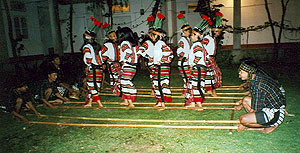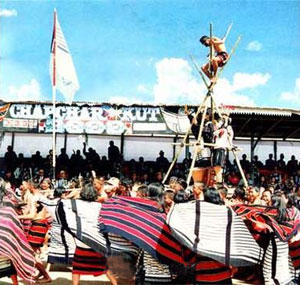|
|
|
Mizoram Dances |
|
|
Some of the
major dances of Mizoram are Cheraw, Khuallam, Chheih Hla (Chheih
lam) and Sawlakia. Besides these, various dances like Chai,
Rallu Lam, Sarlamkai and Par lam are also performed. These
dances are performed on certain festivals, marriages or any
other occasions. |
|
|
Cheraw
is the most colourful and distinctive dance of the Mizos.
This dance was brought by the forefathers of Mizos when
they left their homes in far-east Asia. In earlier days,
the dance was performed to ensure a safe passage for the
departed souls of mothers who died at childbirth, so
that she may enter the abode safely. But nowadays,
Cheraw dance is performed on any occasion. Cheraw is a
dance of sanctification and redemption performed with
great care, precision and elegance. |
 |
|
|
In this
dance, long bamboo sticks are used, so it is also known as the
Bamboo Dance. The dancers step alternatively in and out from
between and across a pair of horizontal bamboos, held against
the ground by people sitting face to face on either side, in a
graceful manner. They tap the bamboos in rhythmic beats. The
bamboos, placed horizontally, are supported by two bases, one
at each end. The bamboos, when clapped, produce a sound which
forms the rhythm of the dance. The patterns and stepping of
the dance have many vibrations.
Chheih Lam
The Chheih Lam dance is performed over a round of rice beer.
This dance is performed on any occasion, usually in the
evenings. It symbolizes the end of a day’s work on the fields.
The lyrics in triplets are normally fresh and on the spot
compositions, representing their heroic deeds and escapades
and also praising the honoured guests. It is a dance that
embodies the spirit of joy and exhilaration. The Chheih lam
dance is performed on the Chheih hla song. The song is sung to
the beats of a drum or bamboo tube or clapping of hands.
People squat on the floor in a circle while a dancer stands in
the middle reciting a song with various movements of limbs and
body. An expert Chheih dancer performs his part in such a
manner that the people around him leave their seats and join
the dance.
Sawlakia
The Sawlakia dance was performed mainly by the people of the
Maras and Pawi communities of Mizoram. Like Rallu lam,
Sawlakia was also performed in earlier times to celebrate a
victory in war. The dance is marked with five principal
movements, and recapture the actions of a hero at war. Men and
women stand in profile, while the hero, holding a sword and a
shield, dances in the middle on the gong beats.
Chai
Chai is a festival dance. It is a community dance where men
and women stand one after another in a circle, and hold each
other on the shoulder and the nape. The dancers dance and
swing their feet to the tune of the song, sung in chorus by
all of them, while a drummer and gongman beat their
instruments used in the dance. The Chai dance presents a grand
show, but is not performed on the stage. In olden days, the
Chai dancers used to consume rice-beer continuously while
dancing, so they did not know when to stop. |
|
|
|
|
|
Khuallam
In Mizo language, Khual means a guest and lam means
dance. So, Khuallam is the dance of the guest. The Mizos,
in the pre-Christian days, believed that the soul, after
death went either to 'Pialral' or paradise, or 'Mitthi
Khua', a land of sorrow and misery. To have a place in
paradise, one had to prove one's mettle either in war or
in hunting or by being a man of distinction in society.
To claim a distinguished place in society, one had to
perform various ceremonies which included offering
community feasts and dances. These ceremonies performed
together, were known as 'Khuangchawi'. While performing
Khuangchawi one was obliged to invite relatives from
nearby villages. So, the guests entered the arena of the
Khuangchawi. The dance is performed by men dressed in
Puandum, to the tune of gongs and |
 |
|
|
drums.
Rallu Lam
Rallu Lam is not a dance, but is rather a celebration or a
rite in honour of a victorious warrior. When a warrior comes
back after a successful campaign, he is given a warm and
colourful welcome by the village Chief. The celebration
consists of a re-enactment of the warrior's heroic exploits.
The mode of celebration varies from village to village.
Sarlamkia
Sarlamkai is one of the most impressive community dances of
Mizos and a variation of Sawlakia dance. The two dances are
almost same. But, the only difference is in their dress and
tempo. No song is sung, only gongs or cymbals or drums are
used. Nowadays, Sarlamkai has been taken up by most of the
schools in Mizoram for cultural activities.
Par Lam
The Par lam is a new dance and has become a part of the Mizo
culture. In the Par lam dance, the girls dressed in colourful
dresses, with flowers tucked in their hair, dance to the tune
of songs sung by themselves. The principal movement in the
dance involves the waving of hands. A couple of boys provide
music by playing guitars. |
|
|
|
|
|
|
|
|
|
|
|
|
|
|
|
|
|
|
|
|
|
|
|
|
|
|
|
|
|
|
|
|
|